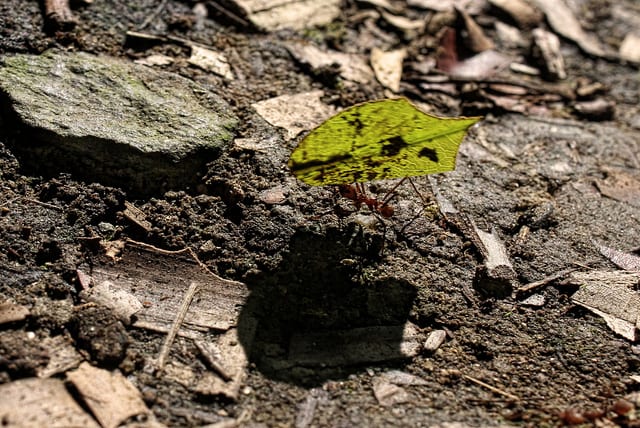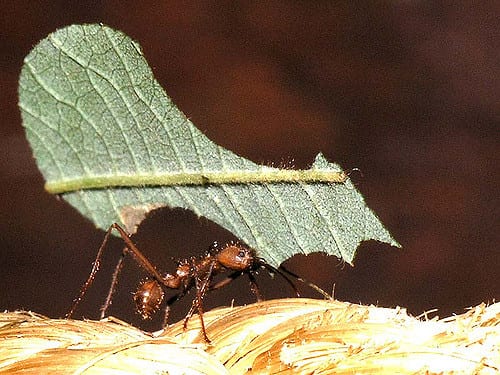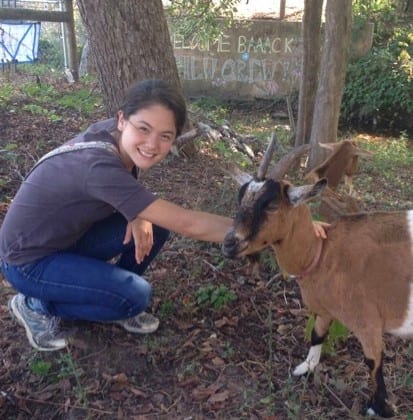We're familiar with ants as picnic-skimming and foot-biting pests, but just below the soil's surface, ants live surprisingly complex and intricate lives. The leaf cutting ants, or leaf cutters, live in a way that's particularly alien to us, as the dominant herbivore (or perhaps “fungivoreâ€) of South American rainforests.

Ant colonies as superorganisms
Rather than acting independently, leaf-cutter ants act on behalf of their colonies can be considered “superorganisms†because the ants work together to “process,†not consume, huge amounts of vegetation. Rather than providing nutrition to the ants, the leaves, flowers, fruits, and seeds serve as food and growing substrate for a fungus that provides nutrients to the colony.
Fungus Farmers
As cultivators of fungi for food, leaf-cutters are classified as one of 200 Attine species, which allgather plant fragments, feces, insect corpses, and other organic material into their nests to feed, and grow their fungus. This symbiotic relationship is called “obligate mutualism†because attines rely on the fungi as much as the fungi need the ants to provide vegetative substrate.
The ants' massive underground (up to 50 ft deep!) nests provide ideal conditions for the Leucogaricus fungus. The nests provide protection from parasites and their complex networks of fungus chambers, tunnels, and vents maintain a comfortable temperature and humidity for the fungal gardens. The agricultural revolution of fungus cultivation with fresh vegetation was crucial to these ants' domination of tropical rainforests, allowing colonies to not only survive, but to thrive.

Ants: Like Us?
Despite their small stature, ants actually have a lot in common with humans! They've organized themselves complex agricultural societies, they use antibiotics to keep pathogens at bay, and they even communicate with one another to efficiently exploit available resources.
In some respects, these tiny bugs may have even surpassed mankind! As individuals, they are champions of heavy-lifting, as they can three times their body weight (that's the equivalent of 250 kg for a human!), and they work tirelessly day and night to haul leaves into their nests.
The leaf-cutters' “megacity†nest is run by millions of self-sufficient “farmer†ants, and could even be called a civilization. The daily forest defoliation by a colony is comparable to a day's worth of grazing for a cow. They even pave extensive foraging roadways for smoother transportation. And they're much more experienced that we are- they have been doing this for about 50 million years, while modern-day humans have only been around for 0.2 million years!
These creatures also exceptionally loyal to their queen. Female workers serve the queen's needs in every capacity throughout their short lives, whether it be leaf-cutting, carrying, cleaning, nest building, or defending. Without this united mission, the colony is doomed.
Without their queen, there is no reproduction, no workforce, no leaves, no fungus, no farming, and therefore no food. While many people are individualistically driven, leaf-cutters are quite the opposite, living their lives without complaint so that “the whole is greater than the sum of its parts.â€
 Suzie Henderson is an undergraduate student in the Odum School of Ecology at the University of Georgia where she helps tend to the Chew Crew. She enjoys learning, gardening, cooking, and her family and friends. Connect with her on Facebook or email her at suzieuga@uga.edu. More from Suzie Henderson. Suzie Henderson is an undergraduate student in the Odum School of Ecology at the University of Georgia where she helps tend to the Chew Crew. She enjoys learning, gardening, cooking, and her family and friends. Connect with her on Facebook or email her at suzieuga@uga.edu. More from Suzie Henderson. |
About the Author
- athenssciencecafehttps://athensscienceobserver.com/author/athenssciencecafe/April 17, 2020
- athenssciencecafehttps://athensscienceobserver.com/author/athenssciencecafe/April 12, 2020
- athenssciencecafehttps://athensscienceobserver.com/author/athenssciencecafe/April 3, 2020
- athenssciencecafehttps://athensscienceobserver.com/author/athenssciencecafe/March 30, 2020







